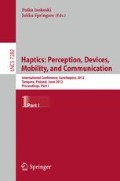Abstract
In this paper, we focus on modifying the identification of an angle of edges when touching it with a pointing finger, by displacing the visual representation of the user’s hand in order to construct a novel visuo-haptic system. We compose a video see-through system, which enables us to change the perception of the shape of an object a user is visually touching, by displacing the visual representation of the user’s hand as if s/he was touching the visual shape, when in actuality s/he is touching another shape.
We had experiments and showed participants perceived angles of edges that was the same as the one they were visually touching, even though the angles of edges they were actually touching was different. These results prove that the perceived angles of edges could be modified if the difference of angles between edges is in the range of − 35° to 30°.
Access this chapter
Tax calculation will be finalised at checkout
Purchases are for personal use only
Preview
Unable to display preview. Download preview PDF.
References
‘phantom’, http://www.sensable.com
Hoshino, H., Tachi, S.: Realization and utillization of 3d cyber space. a method to represent an arbitrary surface in encounter type shape representation system. Transactions 4, 445–454 (1999)
Iwata, H.: Project feelex: adding haptic surface to graphics. In: SIGGRAPH 2001 Conference Proceedings, pp. 469–475 (2001)
Lecuyer, A., Coquillart, S., Kheddar, A., Richard, P., Coiffet, P.: Pseudo-haptic feedback: Can isometric input devices simulate force feedback. In: Proc. IEEE VR, pp. 83–90 (2000)
Ban, Y., Kajinami, T., Narumi, T., Tanikawa, T., Hirose, M.: Modifying an Identified Angle of Edged Shapes Using Pseudo-haptic Effects. In: Isokoski, P., Springare, J. (eds.) EuroHaptics 2012, Part I. LNCS, vol. 7282, pp. 25–36. Springer, Heidelberg (2012)
Mrrray, D.J., Ellis, R.R., Bandomir, C.A., Ross, H.E.: Charpentier (1891) on the size-weight illusion. Perception and Psychophysics, 61 (8) (1999)
Lecuyer, A.: Simulting haptic feedback using vision: A survey of research and applications of pseudo-haptic feedback. Teleoperators and Virtual Environments 18(1), 39–53 (2009)
‘powercursor’, http://www.powercursor.com/
van Mensvoort, K.: What you see is what you feel: exploiting the dominance of the visual over the haptic domain to simulate force-feedback with cursor displacements. In: Proceedings of the 4th Conference on Designing Interactive Systems: Processes, Practices, Methods and Techniques, pp. 345–348 (2002)
Pusch, A., Martin, O., Coquillart, S.: Hemp–hand-displacement-based pseudo-haptics: A study of a force field application and a behavioural analysis. International Journal of Human-Computer Studies 67(3), 256–268 (2009)
Iesaki, A., Somada, A., Kimura, A., Shibata, F., Tamura, H.: Psychophysical influence on tactual impression by mixedreality visual stimulation. Transactions of the Virtual Reality Society of Japan 13(2), 129–140 (2008)
Lecuyer, A., Burkhardt, J.M., Tan, C.H.: A study of the modification of the speed and size of the cursor for simulating pseudo-haptic bumps and holes. ACM Transaction on Applied Perception (ACM TAP) 5 (2008)
Gibson, J.J.: Adaptation, after-effect, and contrast in the perception of curved lines. Journal of Experimental Psychology 16, 1–31 (1933)
Rock, I., Victor, J.: Vision and touch: An experimentally created conflict the two senses. Science 143, 594–596 (1964)
Kohli, L.: Exploiting perceptual illusions to enhance passive haptics. In: IEEE VR Workshop on Perceptual Illusions in Virtual Environments, pp. 22–24 (2009)
Nakahara, M., Kitahara, I., Ohta, Y.: Sensory propety in fusion of visual/haptic cues by using mixed reality. In: Second Joint Eurohaptics Conference and Symposium on Haptic Interfaces For Virtual Environment and Teleoperator System (2007)
Johansson, R.S., Birznieks, I.: First spikes in ensembles of human tactile afferents code complex spatial fingertip events. Nature Neuroscience 7(2), 170–177 (2004)
Author information
Authors and Affiliations
Editor information
Editors and Affiliations
Rights and permissions
Copyright information
© 2012 Springer-Verlag Berlin Heidelberg
About this paper
Cite this paper
Ban, Y., Kajinami, T., Narumi, T., Tanikawa, T., Hirose, M. (2012). Modifying an Identified Angle of Edged Shapes Using Pseudo-haptic Effects. In: Isokoski, P., Springare, J. (eds) Haptics: Perception, Devices, Mobility, and Communication. EuroHaptics 2012. Lecture Notes in Computer Science, vol 7282. Springer, Berlin, Heidelberg. https://doi.org/10.1007/978-3-642-31401-8_3
Download citation
DOI: https://doi.org/10.1007/978-3-642-31401-8_3
Publisher Name: Springer, Berlin, Heidelberg
Print ISBN: 978-3-642-31400-1
Online ISBN: 978-3-642-31401-8
eBook Packages: Computer ScienceComputer Science (R0)

